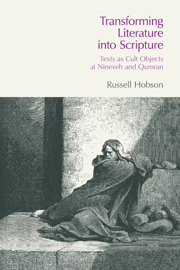Book contents
- Frontmatter
- Contents
- Acknowledgements
- Abbreviations
- 1 Authoritative Texts in the Hebrew and Cuneiform Traditions
- 2 Formulating a New Comparative Approach
- 3 Choosing the Right Texts
- 4 Study One: Enūma Anu Enlil Tablet 63
- 5 Study Two: Mul.Apin
- 6 Study Three: The Laws of Hammurabi
- 7 Study Four: Tablet XI of the Epic of Gilgamesh
- 8 Study Five: Mīs Pî
- 9 Study Six: Manuscripts of Pentateuchal Texts from Near the Dead Sea
- 10 Interpreting the Evidence
- Notes
- Bibliography
- Index of Ancient References
- Index of Authors
- Index of Subjects
5 - Study Two: Mul.Apin
- Frontmatter
- Contents
- Acknowledgements
- Abbreviations
- 1 Authoritative Texts in the Hebrew and Cuneiform Traditions
- 2 Formulating a New Comparative Approach
- 3 Choosing the Right Texts
- 4 Study One: Enūma Anu Enlil Tablet 63
- 5 Study Two: Mul.Apin
- 6 Study Three: The Laws of Hammurabi
- 7 Study Four: Tablet XI of the Epic of Gilgamesh
- 8 Study Five: Mīs Pî
- 9 Study Six: Manuscripts of Pentateuchal Texts from Near the Dead Sea
- 10 Interpreting the Evidence
- Notes
- Bibliography
- Index of Ancient References
- Index of Authors
- Index of Subjects
Summary
The Text
The following analysis relies primarily on the critical edition of the manuscripts published by Hunger and Pingree. The composition known as Mul.Apin is a series comprising two, or possibly three, tablets which are concerned with a range of astronomical phenomena, calendrical information, and omena. Recent research has posited that the originating locale of this astronomical compendium may have been either Ashur or Nineveh, though a southern origin has also been suggested. The text is contained in a series of two tablets of four columns each, the first tablet of which will be examined here.
The Manuscripts
All of the preserved tablets date to the first millennium bce and appear to be from both Babylonian and Assyrian sources. The following list uses the same sigla as those assigned by Hunger and Pingree.
Description of the Sources
A, BM86278
The script of this tablet is Neo-Babylonian. The colophon states that this is “DUB.1.KAM MUL.APIN […kīma] larīršu šatirma bari, “tablet one of Mul.Apin […according to] its original, written and checked.” The museum registration number suggests that this tablet was removed from Babylonia late in the second half of the nineteenth century, in uncontrolled excavations. Weidner considered this tablet to have been produced in around the third century bce. Little else can be said regarding its provenance. A drawing of the tablet was published in 1912 by L. W. King.
- Type
- Chapter
- Information
- Transforming Literature into ScriptureTexts as Cult Objects at Ninevah and Qumran, pp. 47 - 61Publisher: Acumen PublishingPrint publication year: 2012



